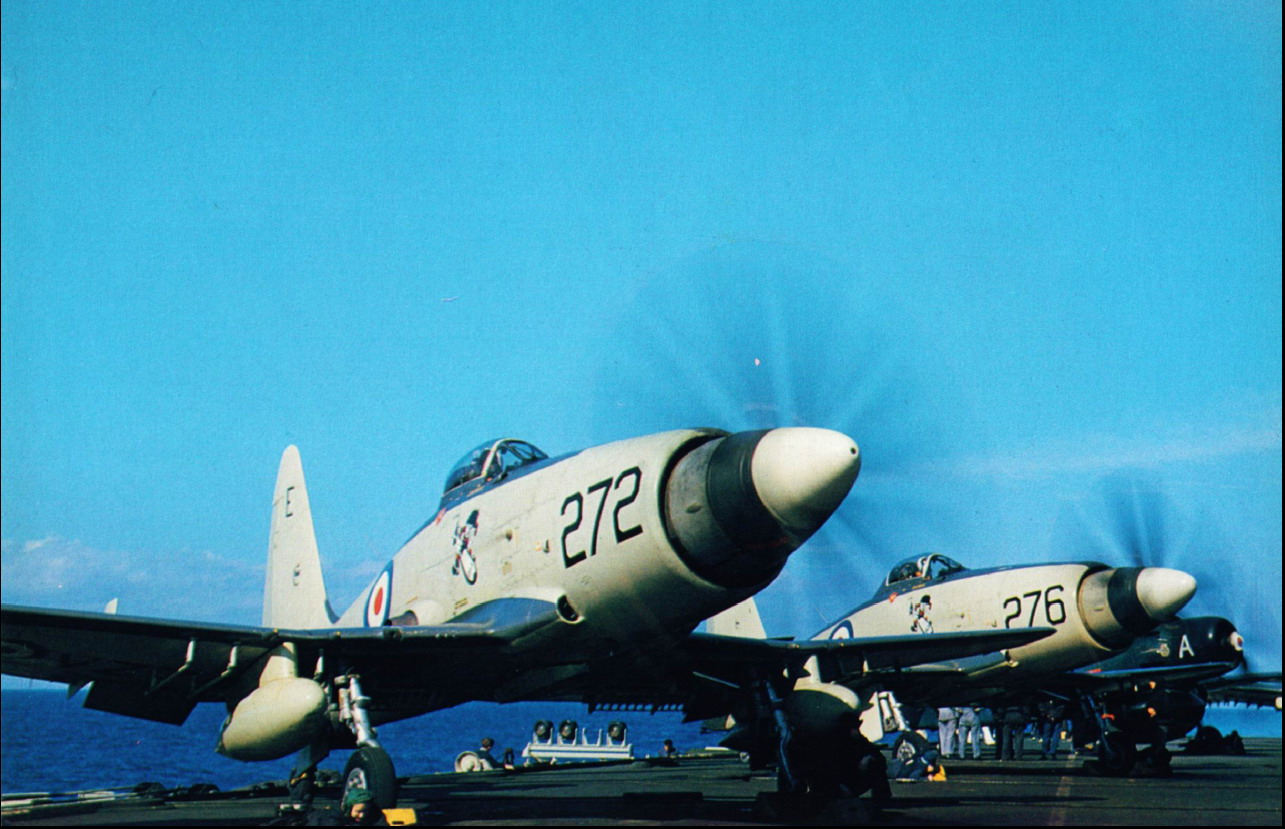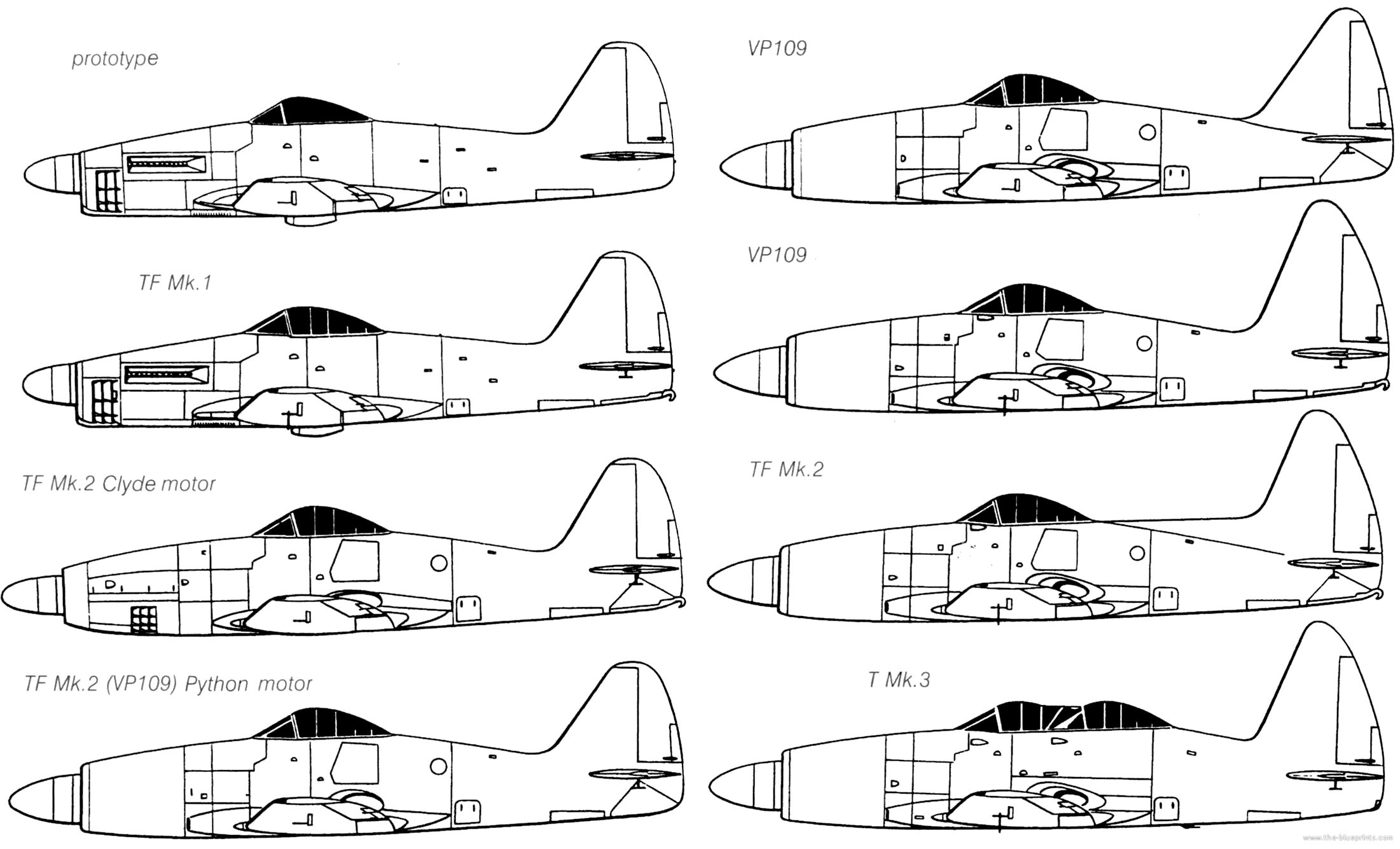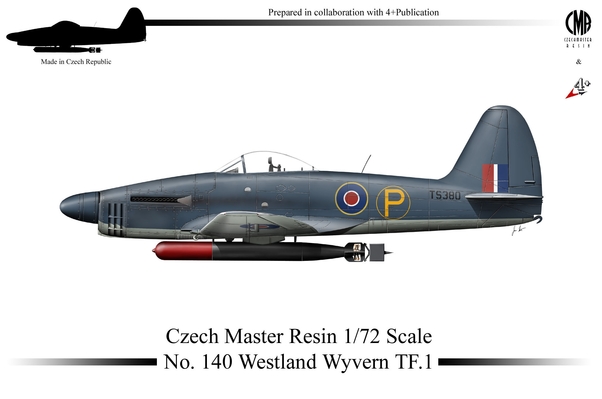I always bean a fan of diferent aircrafts like Westland Wyvern first turbo-prop and like an aviation lover and a "just fun" modelist, was a model to my stash. A combat veteran in Suez, a radical turbo-prop, in a Jet time, never was a priority to Royal Navy with the motor being canceled (first the Clyde and then the Eagle), ended with the Pyton engine, who as not good enought. Only 124 planes were done and they were used by 4 squads during only 4 years (specially TF4 later S4). Many acidents and two lost in the Operation Musketeer, but was a pretty aircraft. To bad is a rare and expensive model (the new not the old ones), if not i will get 3 our 4 to make the most significant type's, but i have faith.
 |
| Fig. 1- A par of Wyvern's at HMS Eagle deck. |
Wyvern begin has a concept for Royal Navy fighter, with eagle radial engine located behind the pilot cockpit, driving a propeler in the nose via a long shaft like Aircobra WWII aircraft, but whit an airframe design that could in future recived a turboprop when available. But the problems beggin in 1947 when the W24 prototype was lost when propeller bearings fail and pilot Peter Garner was kill, before an emergency landing.
Besides all significant problems the aircraft was navalized and biggin weapons trials with prototype number 3, with plane enter in service, with 4 squadrons in Royal Navy (813, 827, 830 and 831 Squadrons of Fleet air Army), that served especially abord HMS Eagle, but with the first carrier tests made abord HMS Illustrious.
_flight_deck_with_Wyverns_1956.jpg) |
| Fig.2 - Besides HMS Eagle (seen here), Wivern's made sea trials from HMS Illustrious. |
Full operations were made with only S4, more advanced than the original Tf mk2 (a model that introduce injection seat on the type and was never in a operactional squadron), who replace the also equally problematic Firebrand. and in 1954 Wyvern's were embarked abord HMS Albion but was in HMS Eagle that the 830 sqd (831 sqd was also present) see combat with 79 sorties at Operation Musketeer in the Suez Crisis, were two Wivern's were lost to egyptian AA (but the pilots eject in the see and were rescued by SAR helicopters from the carrier).
The missions were ground atack to targets like bridges and roads, using rockets, bombs and also the 20 mm internal guns. But with less than 80 combat missions and with the lost of two S4's, it was obvious that was not the Skyraider.
 |
| Fig.3 - A par of Wivern's heat the engines. At bottom a AD1-Skyraider. |
The Jet era and the constant engine problems of the Wyver's, made the Royal Navy only use them in the 50's, and for only few time. When an aircraft doesn't have the engine for what was original planned the results never are good, and S4 had a radical operation system, with first turboprop build in serie with also the double propeler, made him to advanced to is time. Lack of investment to resolve the problems or to advance to the W34 Jet Wyvern, made the plane die. Constant accidents and about 13 casualties finish in less then half decade with the operation of about 100 of this fighter-bomber's. In a conflit like Bouneu, Wyvern S4 with most of the problems fixed, may had been important in atack role, but in the 60's all of them were junk. Only one is today at the museum.
 |
| Fig.4 - One of the critical moments for Westland Wivern was when he was in the catapult ready to be lauch. Engine problems and overheating sometimes make the aircraft caught on fire. |
So, Westland Wyvern is an interesting subject to modeling, by so many reasons since combat experiênce, to inovation or by is shoort time in active service. And there are some interesting Wyvern models in my election scale, from the more recent Trumpeter (also in 1/48 scale) to the old and vintage Frog 1/72 model, with Hasegawa in the midle (a re-launch from the old Frog one).
Best option to the ones like me that work almost in 1/72 is fine Trumpeter, but i'm a fan of vintage kits, so the one from Frog or Hasegawa, is a total blast. Experts have the Chezmaster resin models, with more options like the TF 1, since the others have the S4, early and late.
 |
| Fig.5 - Another sucess lauch from HMS Eagle. |
Frog kit is in a low price (about 5 euros), so for who like a good challenge is the right choice, and with 3 our 4, we can make most of the basic versions, like TF2 or W36 jet Wyvern. I think i have only one, and indecision is the main reason for being in the box, because there's a portuguese "what if" concept (the american is also very nice), but is much more cool to do the war veteran from Suez Canal air strikes or the lost ones to the AA from Egipt ground forces.
Like the Me 109 from WWII that i have about 5 to make and 2 done, it's easy to pick a version, but with only one, the best option is to buy more, at least to do S4 of the Royal Navy and the A2D (american version of Wyvern), from Portuguese Air Force.
 |
| Fig.6 - A Great painting from Wivern (credits to Chris French), were we can se the great design and lovely lines of the aircraft. But was a prop in a jet time. |
Probably the AD2 will have rockets pod, gun pods and 250 kg or 500kg geral use bombs, but napalm is also a choise, for a supposed atack plane of the Colonial African Conflit in the 60's and part of the 70's. A green and gray camouflage (in late war years, most of the planes are antiradiation green) in a jungle cenario, will be exelent in a dirty track of the Portuguese Guinea.
Tf Mk2 or W36 seems also easy to make, from Frog or Hasegawa kit (Trumpeter is to do the english version, not to play around), and with a ground atack configuration or in the last case, air-to-air fight, could also be very cool. Again, let's see what Ebay, modeling sides or one or two stores have to offer, and at a nice and fair price. Maybe future will bring sun after all.
 |
| Fig. 7 - Another critical moment was to land the Wyvern. The first injection submerged was made on the Wyvern who fall down in the sea from a carrier when was landing. |
http://forum.keypublishing.com/showthread.php?141032-Westland-Wyvern-70th-Anniversary-first-flight
 |
| Fig.9 - Another typical amament cargo was rockets. |
https://www.amazon.com/72-British-Westland-Wyvern-TSM1619/dp/B000BMVYIY
 |
| Fig.10 - Heavy anti-ship cargo, with rockets and a torpedo under the fuselage. |
http://www.airliners.net/photo/UK-Navy/Westland-Wyvern-S4/1289704
 |
| Fig-11 - Another crash acident wiht a S4 . The pilot was intact. |
https://books.google.pt/books?id=CP6F4b7RT4oC&pg=PT180&lpg=PT180&dq=westland+wyvern+in+action&source=bl&ots=X0xA3GYPjW&sig=gHW8P-HIxf4p0AmeJG6EHsNZBwY&hl=pt-PT&sa=X&ved=0ahUKEwiMlLnVqZXUAhVGExoKHT-ECaw4ChDoAQhDMAU#v=onepage&q=westland%20wyvern%20in%20action&f=false
 |
| Fig. 12 - Concept, prototype, TF2 and jet Wyvern |
http://www.avionslegendaires.net/avion-militaire/westland-wyvern/
 |
| Fig.13 - The diferent Wyvern's t'll T.Mk 3 |
https://www.aviationsmilitaires.net/v2/base/view/Model/1141.html
 |
| Fig. 17 - Wyvern's prototype. |
https://www.scalemates.com/search.php?q=%22westland+wyvern%22
 |
Fig-18 - T3 and the final and operacional S4
|
http://www.militaryfactory.com/aircraft/detail.asp?aircraft_id=1482
 |
| Fig 19 - Wyvern S4 radical concept. The first operacional and serial turboprop aircraft, with contra- rotating propeller pay a high price for being a new model. |
 |
| Fig.20 - Cockpit of a Wyvern. |
_flight_deck_with_Wyverns_1956.jpg)











